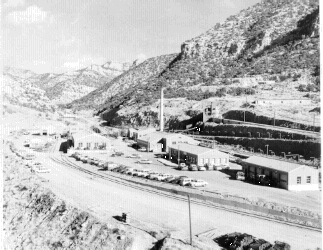
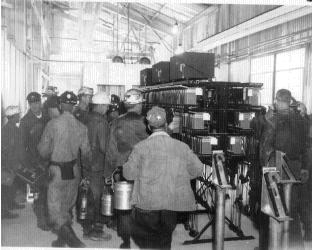
Index For This Page
(Return to Utah Coal Index Page)
By Donald P. Butler, February 1961
(Mirrored and reformatted from the original at http://www.carbon-utgenweb.com) (no longer available)
This paper is a general report of the complete operation of the production of coal at the Geneva Coal Mine at Horse Canyon, Utah, which is the primary source of coal for the Geneva Steel Plant in Provo, Utah. The mine is located on the border of Carbon and Emery Counties and is about 10 miles south of Dragerton, Utah.
Most of my sources of information were obtained from the Mining Engineering Department and the Mine Inspection Department at the main office of the Geneva Mine, which is located in Dragerton. They also furnished the many photographs of the mine, which appear throughout the paper. I was granted permission to visit the mine and my father guided me through during an actual working shift. While I was there, I witnessed all the processes and operations which are carried out to produce the coal.
I have added a glossary to the paper which includes many common coal mining terms that may not be clear to the reader.
The story of coal in eastern Utah begins about one and one half million centuries ago.(1) Coal, which is of organic origin, was formed from the remains of living things such as trees, herbs, shrubs, vines, and other plant material which flourished on the earth long before the time of man. This mild, moist period is often referred to as the Carboniferous Age. Coal is actually the fossilized material which was buried in layers by changes in the surface of the earth. These layers, or seams, were formed when water came into this vegetation and gradually formed new soil at the bottom. This process continued for a long period of time until the vegetation was decayed and buried, forming a coal seam. The character of the coal depends upon the nature of the original plants, the type of decay which took place, and the time involved during burial and formation.(2)
Most of the world's high-grade coal was formed from 150 to 280 million years ago during the Carboniferous Age. Low grade coal was formed later, principally during the Cretaceous Period and the Eocene Period. Coal is still being formed in small quantities today, but hundreds of thousands of years are required to complete the process.(3) There are two main classes of coal: Bituminous, which is soft coal, and Anthracite, which is hard coal. Bituminous is more plentiful and is used much more extensively than Anthracite.
Coal was known of and used as a fuel before the beginning of the Christian Era. One of the earliest records of the utilization of coal dates back to the 4th Century B. C., when the local smiths in Greece used what they called "fossil substances," or coal, as their fuel.
When coal was first discovered, it was used primarily as a fuel, and was not mined extensively. When the iron industry started, however, it brought about a greater demand for coal, and the mining industry expanded quickly. The extensive full scale mining of coal was first carried on in Great Britain during the 13th Century. (4)
As World War II was approaching, the United States Government launched a program to increase the steel production capacity of the nation. After the Pearl Harbor Attack, the policy of establishing steel mills near the sources of raw materials and away from threatening bomb areas was adopted. The Geneva Steel Plant in Provo, Utah was one of these plants, and it necessitated the opening of more coal mines. This was the reason for the establishment of the Geneva Mine at Horse Canyon.(5)
The mine is located at Horse Canyon, Utah, which is on the eastern rim of Castle Valley. It is 35 miles southeast of Price, Utah, and approximately 160 miles southeast of Salt Lake City.(6) It is located 128 rail miles southeast of the Geneva Plant in Provo.(7)
The construction of the mine was started in the Spring of 1942, and the actual underground work in the coal seam began in the following October. The main development openings were driven while the surface plant was still under construction. The coal which was produced at this time was treated by a small capacity temporary tipple. A 1300 foot rock tunnel was driven to the coal seam, and a rotary dumping station was installed.
The mine was developed and organized under the general direction of Mr. F. V. Hicks, the first general superintendent.(8)
In December, 1943, the Geneva Steel Company began operating the mine for the Defense Plant Corporation, which was a United States Government Agency. On June 16, 1946, the mine was purchased from the War Assets Administration by the United States Steel Corporation, and was operated by the Geneva Steel Company until January 1, 1952, when the Geneva Company became a part of the Columbia-Geneva Steel Division.(9)


Figure 1. (Left) The surface plant at the mine. The mine portals are located at the top left of the picture.
Figure 2. (Right) Employees checking out headlamp batteries before entering the mine.
Just a few years after its beginning, the Horse Canyon mine was, and still is, one of the largest producing coal mines west of the Mississippi River. The mine has produced approximately 5000 tons per day on a two 8 hour shift basis. The total number of underground employees is 458.(10) In 1957, 490,000,000 tons of Bituminous coal were produced in the United States.(11) The Geneva Mine at Horse Canyon produced approximately 1,700,000 tons during the same year.(12) Thus, in 1957, the Geneva Mine produced about 0.35 percent of the Bituminous coal produced in the United States.
The seams at Horse Canyon are found in the Bookcliffs, a mountain range on the eastern rim of Castle Valley. They dip eastward at an incline, or pitch, of 12.5 percent. This means that the pitch of the slope lowers approximately 12-1/2 feet for every 100 feet as it progresses eastward.
The rock layers surrounding the coal seams are mainly sandstone and they vary from a few feet to as much as 50 feet in thickness. Shale is very prevalent and the sandstone beds are usually interbedded with sandy shales. Some limestone beds are also present. The depth of cover over the mined areas varies from 300 feet to approximately 2,900 feet with an average of more than 1,000 feet.
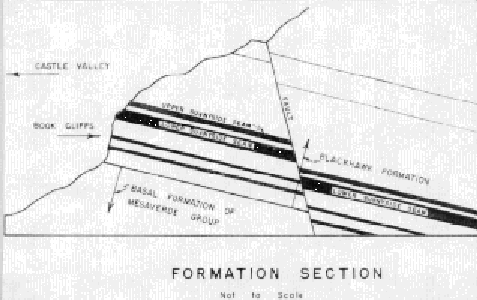
Figure 3. A typical formation section of the coal seams of the Horse Canyon area. It illustrates the incline of the seam, the formation of the seams, and a typical fault.
The coal seam that is mined is called the Lower Sunnyside Seam and it varies from 7 to 16 feet in thickness. The elevation of this seam is 6355 feet at the mine portal. The seam is relatively free from bone or partings except in the extreme southeast and northern sections of the mine. Beneath the seam is a layer of sandstone that forms a shelf along the outcrop of the coal seam. Above the seam is a bed of thin sandstone and sandy shale that averages 3 feet in total thickness, and over this parting lies the Upper Sunnyside Seam which is about 3 feet thick. This upper seam, often called the rider seam, is not mined at the present time.
The coal that is mined is hard, sub-bituminous, high volatile coking coal, which has a low sulfur and ash content.(13)
The occurrence of faults in the mine is quite frequent. Faults, in geology, are fractures which move the layers of the earth's crust. One of the masses of earth is uplifted and is called the upthrow, and the other is depressed and called the downthrow. The amount of displacement varies considerably.(14)
Most faults in the mine slope from east to west. Most of them are less than 15 feet in displacement, but there is one of 55 feet and one of about 100 feet throw. The dips of the faults are quite steep, varying from 50 degrees to as much as 70 degrees from the horizontal. The faults seem to occur at about 2000 foot intervals in the southern portion of the mine, but in the northern section, the faulting is irregular, excepting one large normal fault.
The fault system and the pitch of the seam are the main factors controlling the general layout of the mine. The mine consists of one set of east-west slope entries, and three sets of north-south entries, extending along the strike and from the slope entries at intervals of one-half mile each. The north-south entries are called 1st, 2nd, and 3rd levels, beginning at the eastern, or highest one.
Openings have been made into the seam on both sides of the canyon, about one-half mile from the mouth of the canyon. The main entries to the north have been driven approximately 3,100 feet to a major fault zone, which displaces about 40 feet downthrow. This fault has been penetrated and development has continued for another 3,500 feet to a major fault zone that separates the mine from the Columbia Mine, another Geneva mine. The South mine has been extended approximately two miles to the southern boundary of the mine. Three major fault zones were driven through on the South side. The main slope entries are presently approximately 8,000 feet down the pitch.(15)
Many rapid advances in coal mining machinery have brought modern mining equipment to Horse Canyon. At the present time, there are two types of mining districts: conventional trackless mining units and continuous mining units. These units will be explained later.
The general mining plans call for room and pillar mining layouts. The actual mining is accomplished by first mining the upper part of the seam and bolting the roof; (roof bolting will be explained in the next chapter) then, when retreating, the pillars and the lower part of the seam are taken. This procedure is called bench mining. Many other modifications are made to conform to various faults, irregular seam pitch, and other natural conditions. The coal is initially blocked out for mining by primary slope and strike development. The boundaries of the mining districts are established by this primary development and by major fault zones. Secondary development has standardized to where it is similar in districts using either track or conveyor belt haulage.(16)

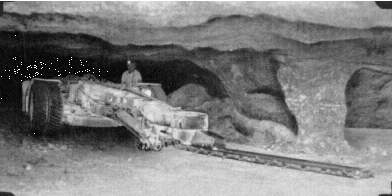
Figure 4. (Left) A view inside the mine which shows the bench mining method. The upper part of the seam has been mined and now the lower part and the pillars are being worked.
Figure 5. (Right) A cutting machine which undercuts the face of the coal prior to blasting.
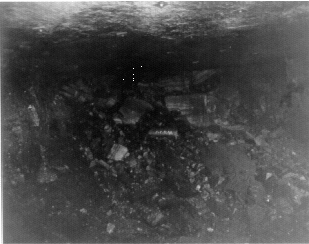
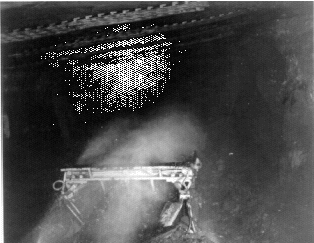
Figure 6. (Left) A portion of broken coal which has recently been blasted.
Figure 7. (Right) The strong ripping teeth of a continuous miner in operation.
In the conventional mining districts, each face of coal being mined is undercut with a cutting machine to a depth of approximately nine feet. Occasionally a center cut is made half way up the face. An electric, hydraulic controlled drill, which is mounted on the cutting machine, is then used to drill holes in the face for blasting powder. Usually fifteen holes are drilled, using three rows of five holes each. The holes are drilled about 6 inches shorter than the undercut made with the cutting machine. This helps to eliminate the possibility of blasting on solid coal.
The coal face is broken up by using a dynamite blast. A charge consisting of from three to six sticks of dynamite is placed into each hole in the face and is electrically detonated with a ten-shot permissible battery. The bottom row of shots is fired first; then the top row is fired. All places are sprinkled with water before, between, and after the shots. This concludes the process of breaking up the coal in the conventional districts.
The other mining districts are mined with continuous miners. There are three different types of continuous miners used in the mine, but they all work in the same way. They break up the coal with huge bits or teeth, eliminating the necessity of blasting. After breaking up the coal, they load the broken coal directly into shuttle cars, which haul the coal to conveyors or rail cars.
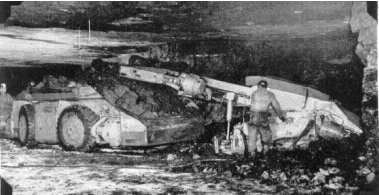
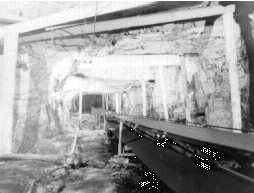
Figure 8. (Left) A loading machine loading coal into a shuttle car.
Figure 9. (Right) A belt conveyor inside the mine.
The haulage system employed at the mine is an outstanding feature of its operation. Beginning at the working face, the coal, which has been broken up by either blasting or by a continuous miner, is loaded into a seven ton shuttle car by a loading machine. The shuttle car then transports the coal and dumps it onto a conveyor belt which, in turn dumps it into eight ton individual suspension rail cars. These rail cars are assembled together into loaded cartrips by electric gathering locomotives. These loaded cars are then hauled to either of two rotary dumping stations. All of the coal that is mined below the 2nd level is hoisted to that level by a 500 horsepower hoist.
A rotary dump is installed at the intersection of the 1st level and the 2nd level with one of the main dip entries. Plans for the installation of a rotary dump on the 3rd level are being made at the present time. Each of the rotary dumps empties one eight ton mine car at a time by turning it over in a rotary motion. The cars need not be uncoupled because they have swiveled couplings. The dumps empty the coal into a hopper which feeds a 54 inch wide conveyor belt. The coal then moves through a series of conveyors and is delivered to the transfer house, which is located on the surface. At the transfer house, the coal is crushed; then it is sent by a 48 inch conveyor to the tipple at the mouth of the canyon.(17)
The crushed coal is then loaded into railroad cars from the tipple, and is transported via the Carbon County Railway and the D & R G W Railroad to the Wellington Coal Washing Plant near Wellington, Utah. At the washing plant, the coal is separated from impurities (rock and other refuse) by "floating" the coal and "sinking" the refuse. Two different processes are used: one for coarse coal and the other for fine coal. After the coal has been washed, the coarse and fine coal are mixed together again and the coal is shipped by rail to the Geneva Steel Plant. At the steel plant the coal is made into coke and used in the process of making steel.(18)
General mine safety is the main factor which governs the operation of the mine. All employees are safety conscious at all times.
There are many safety regulations in the mine which are followed religiously. Governing the safety in the mine are the Federal Coal Mine Safety Act, the Federal Mine Safety Code, the General Coal Mine Safety Orders of Utah, and the Division Coal Mine Safety Manual. These orders and codes are strictly enforced and they incorporate the minimum standards to provide reasonable safety for all workers. Inspections are made regularly under the direction of the Mine Inspection Department to check on these regulations.
In an attempt to create proper safety consciousness among underground employees at all times, safety meetings are conducted weekly. Rules for standard safe procedures are made up for each specific job in the mine. Safety awards, given by the National Safety Council, have been awarded to the mine in recognition of outstanding achievements in preventing injuries from roof falls. Protective Equipment, safety devices, and safe practices all contribute to increased safety and better working conditions in the mine.(19)
In the past, the general roof conditions were best where top coal of more than 4 feet in thickness was left to protect the rock separation between the Upper and Lower Sunnyside Seams. The present mining has now progressed into areas where the rock partings are prevalent and the natural mining conditions are more adverse. Numerous fractures and slips in the coal and cap rock make it impractical and unsafe to support the roof by leaving top coal. Therefore, a new system, called roof bolting, has been put into use.(20)
The roof bolts are used to form a beam of the layers of rock and coal over the coal seam. The bolts vary in length and have an expansion nut at the top which, when tightened, expands and grips the rock and forms the beam. For an example of how they work, if approximately four planks were stacked together and supported at their ends by two saw horses, they will display a definite sag in the center. If, however, they are bolted together in several places, the sag will be eliminated. This is the way the bolts support the roof, eliminating the sag and reducing the pressure on the roof.
The bolts are installed by drilling a hole in the roof with a roof bolting machine. The hole is drilled about an inch longer than the bolt to be installed. A roof bolt plate is placed on the nut end of the bolt, and an expansion nut is placed on the thread end. The bolt is started into the hole; then it is pushed up and tightened by the machine. The bolts are usually tightened to a torque of from 150 to 250 foot-pounds.(21)


Figure 10. (Left) A diagram which shows the expansion nut of a roof bolt and how it clings in place.
Figure 11. (Right) A roof bolting machine in operation. Notice the bolts already in place on the roof.
Where it is practical, the roof bolts are of sufficient length to anchor in the rock layer above the rider seam. If this is not possible, it is made short enough so that it will not penetrate the rider seam. The standard roof bolting plan calls for bolts on four-foot centers with reinforcements of landing mats, channels, or additional bolts as natural conditions require.(22)
Three exhaust fans, each driven by a 75 horsepower motor at 660 rpm, circulate fresh air throughout the mine. There are two seven foot Jeffrey fans and one seven foot Joy exhaust fan.
The Jeffrey fans exhaust the openings north and south of the main hoisting slopes at the rate of approximately 370,000 cubic feet per minute. The other fan, located at Lila Canyon at the extreme southern boundary of the mine, exhausts air from the southern portion of the mine at the rate of approximately 190,000 cubic feet per minute.
The intake air enters the mine through the mine openings at the north and south portals in Horse Canyon and at the opening at Lila Canyon. Middle entries are used to circulate the fresh air and the outer entries are used as returns to the main entries and district entries.
Each working district is on a separate split of fresh air. Brattice lines are used exclusively in all sections of the mine to direct the air to the desired areas. Overcasts are constructed of cinder blocks and reinforced concrete. Permanent air stoppings are constructed of cinder blocks and plastered with cement mortal.(23)
The Geneva Mine would not have been established had it not been for World War II, but certainly has had a tremendous effect on the state of Utah. Dragerton, the nearby mining town with a population of approximately 5000, was built to provide housing for Geneva Mine workers. Geneva Steel Company employs 760 workers in the area, including 630 waged and 130 salaried employees (this includes both Geneva mines - Columbia and Horse Canyon). Assuming that the average family consists of six individuals, multiplying 760 by six will reveal that the Geneva Steel Company has brought approximately 4,560 people to Carbon County, Utah. These people earn nearly $500,000 monthly, and therefore have a great effect on the economy of Carbon County and the state of Utah.
Studies show that with the same equipment and the same average daily production as today, the mine will continue producing coal for approximately 35 to 40 more years, or, until about 2000 A. D.(24)
Brattice Line - a line of canvas or burlap material which separates the intake air supply from the return air and aids in circulating fresh air to the working faces in the mine.
Cap Rock - the rock above the coal seam which usually loosens and caves when the coal is blasted.
Car Trip - an assembly of rail cars which haul coal inside the mine.
Crosscut - an opening which is driven perpendicular to and between the entries.
Development Opening - an entry driven into the coal seam from which room and pillar districts are driven.
Dip - the downward pitch of the coal seam.
Entry - a development opening in the seam.
Exhaust Fan - a fan which exhausts air from the mine.
Fault - a fracture in the crust of the earth which moves the layers of the earth.
Haulage - transportation of coal from the mine.
Outcrop - the coal seam as it appears on the surface.
Overcast - a concrete structure which separates intake air from return air at intersections in the mine by flowing the return air over the intake air.
Portal - an entrance to the mine.
Raise Entry - an entry which is driven up the pitch of the coal seam.
Rib - the side walls of entries, rooms, pillars, etc., in the mine.
Rider Seam - the coal seam which is above the 3 foot rock parting directly above the Lower Sunnyside Seam.
Rock Tunnel - a tunnel which is driven through solid rock in order to intersect the coal seam at the desired elevation and grade.
Rotary Dump - an installation which dumps the coal from eight ton rail cars by inverting them and dumping the coal into a hopper which feeds a conveyor belt.
Slope Entry - An entry which is driven down the pitch of the seam.
Strike Entry - an entry which is driven at a level grade and perpendicular to the pitch of the seam.
Tipple - a plant where the coal is screened, graded, and loaded into railroad cars for transport away from the mine.
Working Face - the immediate area where the coal is being mine.
1. The Story of Coal, U. S. S. Westerners, 3:2 (Feb. 1958), p. 4.
2. Coal, Encyclopedia Britannica (1958 ed.). V, 868.
3. Coal, The World Book Encyclopedia (U. S. A: Field Enterprises, Inc., 1953), III, 1503.
4. Coal, The Encyclopedia Americana (U. S. A: Americana Corp., 1955), VII, 143.
8. Reynolds, op. cit. #5, pp. 252-3.
9. Mining Engineering Dept, op. cit. #6, p. 1.
10. Mining Engineering Dept., op. cit. #6.
12. Training Division, op. cit. #7, p. 8.
14. Faults, The Home University Encyclopedia (Boston, Mass: Books, Inc., 1944), V, p. 1850.
15. Mining Engineering Dept., op. cit. #13, p. 3-4.
17. Mining Engineering Dept., op. cit. #16, pp. 8-9
18. U. S. Steel Corp., The Coal Cleaning Plant of Wellington, Utah, (Provo, Utah, 1958), p. 1.
22. Mining Engineering Dept., op. cit. #20, p. 7.
23. Mining Engineering Dept., op. cit. #20, p. 12.
###